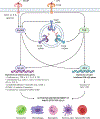Foundational concepts in the biology of bacterial keratitis
- PMID: 34097906
- PMCID: PMC8595513
- DOI: 10.1016/j.exer.2021.108647
Foundational concepts in the biology of bacterial keratitis
Abstract
Bacterial infections of the cornea, or bacterial keratitis (BK), are notorious for causing rapidly fulminant disease and permanent vision loss, even among treated patients. In the last sixty years, dramatic upward trajectories in the frequency of BK have been observed internationally, driven in large part by the commercialization of hydrogel contact lenses in the late 1960s. Despite this worsening burden of disease, current evidence-based therapies for BK - including broad-spectrum topical antibiotics and, if indicated, topical corticosteroids - fail to salvage vision in a substantial proportion of affected patients. Amid growing concerns of rapidly diminishing antibiotic utility, there has been renewed interest in urgently needed novel treatments that may improve clinical outcomes on an individual and public health level. Bridging the translational gap in the care of BK requires the identification of new therapeutic targets and rational treatment design, but neither of these aims can be achieved without understanding the complex biological processes that determine how bacterial corneal infections arise, progress, and resolve. In this chapter, we synthesize the current wealth of human and animal experimental data that now inform our understanding of basic BK pathophysiology, in context with modern concepts in ocular immunology and microbiology. By identifying the key molecular determinants of clinical disease, we explore how novel treatments can be developed and translated into routine patient care.
Keywords: Adaptive immunity; Bacterial keratitis; Corneal infections; Immunology; Innate immunity; Microbial keratitis; Pseudomonas aeruginosa; Staphylococcus aureus; Streptococcus pneumoniae.
Copyright © 2021 Elsevier Ltd. All rights reserved.
Conflict of interest statement
CONFLICTS OF INTEREST
None to declare.
Figures




Similar articles
-
Pharmacokinetic considerations in the treatment of bacterial keratitis.Clin Pharmacokinet. 1994 Aug;27(2):129-49. doi: 10.2165/00003088-199427020-00005. Clin Pharmacokinet. 1994. PMID: 7955776 Review.
-
Types of organisms and in-vitro susceptibility of bacterial isolates from patients with microbial keratitis: A trend analysis of 8 years.Indian J Ophthalmol. 2019 Jan;67(1):49-53. doi: 10.4103/ijo.IJO_500_18. Indian J Ophthalmol. 2019. PMID: 30574892 Free PMC article.
-
Contact lens-related corneal infection: Intrinsic resistance and its compromise.Prog Retin Eye Res. 2020 May;76:100804. doi: 10.1016/j.preteyeres.2019.100804. Epub 2019 Nov 20. Prog Retin Eye Res. 2020. PMID: 31756497 Free PMC article. Review.
-
The use of antimicrobial peptides in ophthalmology: an experimental study in corneal preservation and the management of bacterial keratitis.Trans Am Ophthalmol Soc. 2002;100:243-71. Trans Am Ophthalmol Soc. 2002. PMID: 12545697 Free PMC article.
-
A comparison of antimicrobial regimen outcomes and antibiogram development in microbial keratitis: a prospective cohort study in Alexandria, Egypt.Graefes Arch Clin Exp Ophthalmol. 2024 Jun;262(6):1865-1882. doi: 10.1007/s00417-023-06362-0. Epub 2024 Jan 19. Graefes Arch Clin Exp Ophthalmol. 2024. PMID: 38240778 Free PMC article.
Cited by
-
Galectin-8 Downmodulates TLR4 Activation and Impairs Bacterial Clearance in a Mouse Model of Pseudomonas aeruginosa Keratitis.J Immunol. 2023 Feb 15;210(4):398-407. doi: 10.4049/jimmunol.2200706. J Immunol. 2023. PMID: 36603009 Free PMC article.
-
Advancements in Hydrogels for Corneal Healing and Tissue Engineering.Gels. 2024 Oct 16;10(10):662. doi: 10.3390/gels10100662. Gels. 2024. PMID: 39451315 Free PMC article. Review.
-
Fulminant Eye Infection in a Patient With Nephrotic Syndrome: A Case Report.Cureus. 2024 Mar 9;16(3):e55842. doi: 10.7759/cureus.55842. eCollection 2024 Mar. Cureus. 2024. PMID: 38590483 Free PMC article.
-
An exploration of the ocular mysteries linking nanoparticles to the patho-therapeutic effects against keratitis.J Nanobiotechnology. 2025 Mar 6;23(1):184. doi: 10.1186/s12951-025-03230-3. J Nanobiotechnology. 2025. PMID: 40050881 Free PMC article. Review.
-
Transcriptional profiling specifies the pathogen-specific human host response to infectious keratitis.Front Cell Infect Microbiol. 2024 Jan 11;13:1285676. doi: 10.3389/fcimb.2023.1285676. eCollection 2023. Front Cell Infect Microbiol. 2024. PMID: 38274739 Free PMC article.
References
-
- Abrams GA, Goodman SL, Nealey PF, Franco M, Murphy CJ, 2000. Nanoscale topography of the basement membrane underlying the corneal epithelium of the rhesus macaque. Cell Tissue Res. 299, 39–46. - PubMed
-
- Aho HJ, Saari KM, Kallajoki M, Nevalainen TJ, 1996. Synthesis of group II phospholipase A2 and lysozyme in lacrimal glands. Invest. Ophthalmol. Vis. Sci 37, 1826–1832. - PubMed
Publication types
MeSH terms
Substances
Grants and funding
LinkOut - more resources
Full Text Sources
Medical
Miscellaneous

